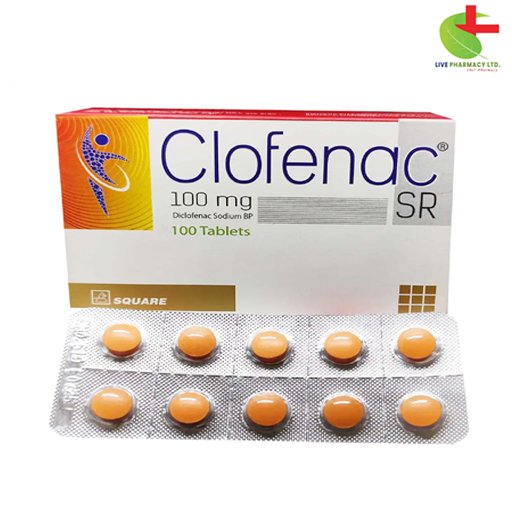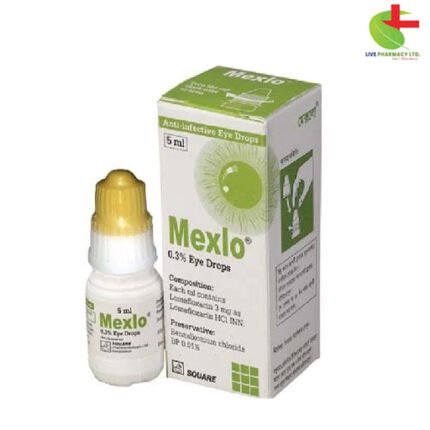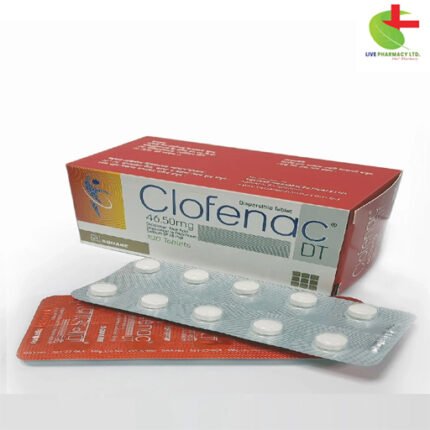Clofenac SR
50.00৳ Strip
- Explore our range of medications for effective relief from various rheumatic conditions, post-surgical pain, and gynecological issues.
- Our potent non-steroidal anti-inflammatory drugs (NSAIDs) offer anti-rheumatic, analgesic, and antipyretic properties for rapid relief.
- Tailored dosages cater to diverse needs, ensuring optimal therapeutic outcomes and personalized treatment plans.
- Trust our commitment to safety and efficacy for comprehensive pain management solutions tailored to your specific needs.
 Brand
Brand
|
Square Pharmaceuticals PLC |
|---|---|
 Generics
Generics
|
Diclofenac Sodium |
Indications
Rheumatology: Effective relief for various forms of rheumatism, including inflammatory and degenerative types, chronic involutive conditions, polyarthritis, ankylosing spondylarthritis, osteoarthritis, spondylarthroses, acute gout, and peri-articular rheumatic disorders.
Surgery and Traumatology: Medications to address sprains, bruises, dislocations, fractures, soft tissue injuries, and post-surgical interventions.
Obstetrics and Gynecology: Assistance with primary dysmenorrhoea, episiotomy, adnexitis, endometritis, parametritis, salpingitis, and mastitis.
Otorhinolaryngology: Pre-operative treatment to prevent pain, inflammation, and swelling.
Dentistry: Post-operative and post-traumatic pain, inflammation, and swelling relief.
Other indications: Aid in pain prevention and treatment of inflammation and swelling for patients undergoing urogenital tract surgeries, renal and biliary colic.
Pharmacology
Dilofenac Sodium is a potent non-steroidal anti-inflammatory drug (NSAID) renowned for its anti-rheumatic, anti-inflammatory, analgesic, and antipyretic properties. It also exhibits uricosuric effects. By inhibiting prostaglandin biosynthesis, it targets inflammation, pain, and fever. Rapid and complete absorption occurs from the gastrointestinal tract, with peak plasma concentrations typically reached within two hours post-ingestion. Metabolized in the liver, it undergoes first-pass metabolism.
Dosage & Administration
- Diclofenac FC Tablet: For adults, the recommended dosage ranges from 75-150 mg daily in 2 to 3 divided doses, preferably after meals. Adjustments are necessary for long-term use.
- Diclofenac SR Tablet: Adults should take one tablet daily, whole with liquid, preferably at meal times. Children’s dosage varies based on weight, while elderly patients should receive the lowest effective dosage.
- Diclofenac Dispersible Tablet: Adults typically take 2-3 tablets daily, not exceeding 150 mg. For children, dosage is based on weight. Preferably taken before meals.
- Diclofenac TR Capsule: One capsule daily, preferably after meals.
- Diclofenac Suppository: For adults, 50 mg suppository 2-3 times daily, not exceeding 150 mg daily.
- Diclofenac Injection: The usual adult dose is 1 ampoule daily, potentially increased in serious cases.
- Diclofenac Gel: Applied externally, 2-4 g should be used 3-4 times daily, depending on the affected area’s size.
Interactions
Caution should be exercised with concomitant use of diclofenac and certain medications, including lithium, digoxin, anticoagulants, antidiabetic agents, cyclosporin, methotrexate, quinolone antimicrobials, other NSAIDs, and steroids.
Contraindications
Patients hypersensitive to any component of the products, those with peptic ulcer, or asthma precipitated by acetylsalicylic acid or similar drugs should avoid diclofenac.
Side Effects
While generally well-tolerated, diclofenac may cause mild, transient adverse effects such as epigastric pain, nausea, diarrhea, dizziness, headache, peripheral edema, skin reactions, and local irritation.
Pregnancy & Lactation
Use diclofenac during pregnancy only for compelling reasons, with the lowest effective dose and avoiding the first trimester. Limited data exist on its safety during breastfeeding.
Precautions & Warnings
Close observation is necessary for patients at risk of peptic ulceration or gastrointestinal bleeding. Avoid contact with eyes or mucous membranes with diclofenac gel, and wash hands after application.
Therapeutic Class
Drugs for osteoarthritis, rheumatoid arthritis, and non-steroidal anti-inflammatory drugs (NSAIDs).
Storage Conditions
Store products in a cool, dry place below 30°C, protected from light, and out of reach of children.













Reviews
There are no reviews yet.